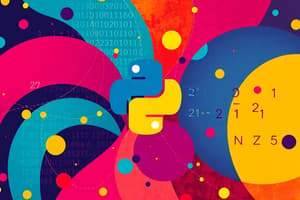Podcast
Questions and Answers
What is the primary goal of business analytics?
What is the primary goal of business analytics?
- To create graphical outputs for presentations
- To focus solely on cleaning data
- To gather, inspect, and model data for decision making (correct)
- To gather and store data without analysis
Which of the following best describes R?
Which of the following best describes R?
- A basic programming language without graphical capabilities
- An integrated suite of packages for various data analysis tasks (correct)
- A commercial software for data handling
- A system limited to Windows operating only
Which component of RStudio allows users to write code?
Which component of RStudio allows users to write code?
- Environment
- Script Window (correct)
- Console
- Graphical Output
What is one of the main benefits of using business analytics?
What is one of the main benefits of using business analytics?
In RStudio, what does the console display?
In RStudio, what does the console display?
What task is NOT typically associated with the roles in business analytics?
What task is NOT typically associated with the roles in business analytics?
What does EDA stand for in the context of data analysis?
What does EDA stand for in the context of data analysis?
Which platform is R NOT available on?
Which platform is R NOT available on?
Flashcards
Business Analytics (BA)
Business Analytics (BA)
A process of gathering, inspecting, cleaning, transforming, and modeling data to find useful information, supporting decisions.
Data Sources
Data Sources
Various places where business data comes from, including documents, apps, social media, sensors, and machine logs.
R
R
A programming language for data handling, manipulation, statistical analysis, creating graphs, and developing models.
R Studio
R Studio
Signup and view all the flashcards
Data Handling
Data Handling
Signup and view all the flashcards
Data Analysis
Data Analysis
Signup and view all the flashcards
Benefits of BA
Benefits of BA
Signup and view all the flashcards
BA Roles
BA Roles
Signup and view all the flashcards
Study Notes
Course Introduction
- Analytical skills are developed for understanding trends in data.
- Topics include exploratory data analysis (EDA), data visualization, handling missing data, statistics, and linear regression.
- R is an integrated suite of software packages for data handling, data manipulation, statistical analysis, and graphical analysis.
- It's open-source and free on all platforms (macOS, Windows, Linux).
- RStudio provides an integrated development environment (IDE) for R.
- RStudio's GUI displays in four windows: script (code), console (output), environment (variables), and plots (graphics).
Overview of RStudio
- R is a programming language for data analysis.
- RStudio is its IDE.
- RStudio allows code writing and result viewing.
Introduction to Business Analytics
- Business analytics is data collection, inspection, cleaning, transformation, and modeling to extract meaningful insights.
- 2021 data volume: 80ZB, projected 2025 volume: 175.2ZB
- Data sources include documents, apps, social media, sensors, logs, and archives.
- Business analytics improves efficiency, productivity, decision-making, financial performance, customer experience, and revenue streams.
- Roles include understanding problems, collecting data, cleaning data, analyzing data, identifying trends, and generating reports.
Business Analyst Skills
- Data cleaning involves detecting and correcting inaccurate data (e.g., removing retweets, handling missing data).
- Exploratory data analysis (EDA) is a process of organizing and understanding data; examples include date formatting adjustments.
Types of Statistics
- Descriptive statistics describe data features (mean, median, mode, range, variance, standard deviation, IQR).
- Inferential statistics uses sample data to make inferences about a population.
Data Visualization
- Data visualization uses charts, graphs, and dashboards to represent data visually.
- Techniques include scatter plots, histograms, line charts, and bar charts to show relationships, distributions, and trends.
Data Visualization in R (ggplot2)
- ggplot2 is an R package used for data visualization using a grammar of graphics approach.
- It allows building plots by combining various components, including data, aesthetics, geometry (visual representation), coordinate system, and facets.
Data Importing and Wording
- R can read different data formats, like CSV, using the data() function.
- Functions like head(), tail(), and str() are helpful with exploring initial data.
- Packages like readr can be used to handle different data formats.
Business Analytics Types
- Descriptive: understanding what happened.
- Predictive: predicting what will happen.
- Prescriptive: determining best actions to take.
Business Analytics Lifecycle
- Defining business requirements,
- Data collection, data cleaning, and exploration,
- Data analysis,
- Developing insights,
- Creating reports and visuals.
Business Analytics Tools
- Python, Tableau, Spark, RapidMiner, Excel, and Google Developers Tools.
Business Analytics Domains
- Travel, marketing, healthcare, social media, sales, automation, and credit/insurance.
R Commands and Data Structures
- Basic R commands and creating different data structures (vectors, data frames).
- Working with data frames (displaying columns, rows, or specific values).
Studying That Suits You
Use AI to generate personalized quizzes and flashcards to suit your learning preferences.
Related Documents
Description
This quiz covers the fundamentals of business analytics and the R programming language. Topics include data analysis techniques, exploratory data analysis (EDA), and the RStudio IDE. Gain insights into handling large data volumes and effective data visualization.




